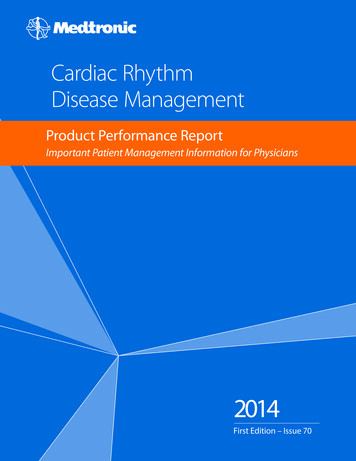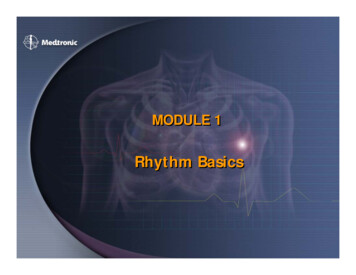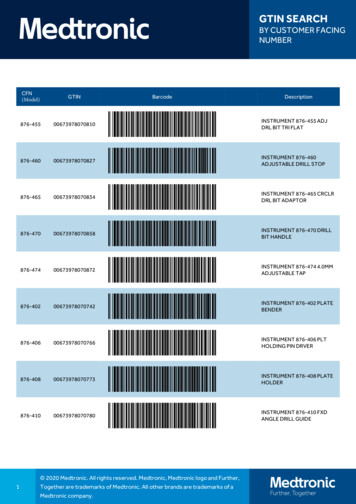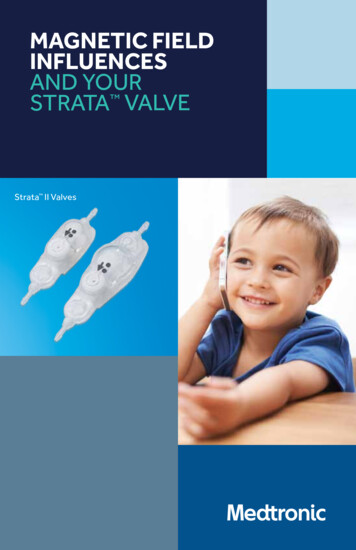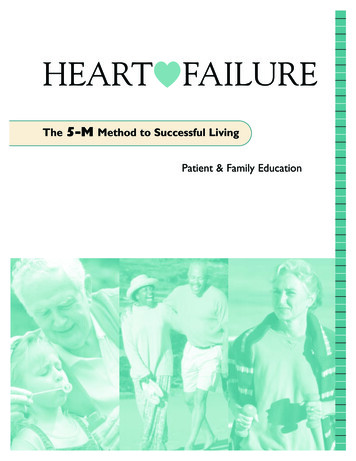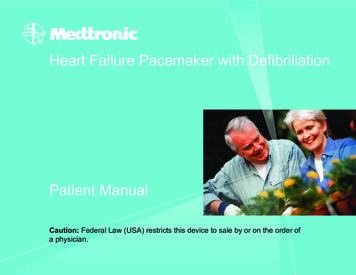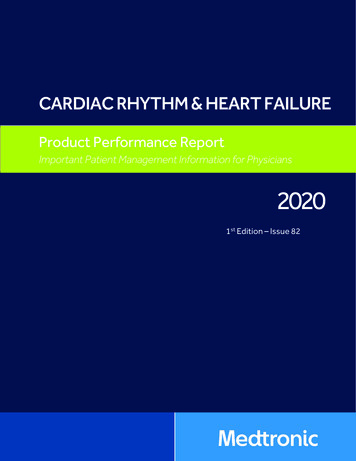
Transcription
CARDIAC RHYTHM & HEART FAILUREProduct Performance ReportImportant Patient Management Information for Physicians20201st Edition – Issue 82
CRHF Product Performance Report20201st EditionIssue 82Introduction3Method for EstimatingCRT, ICD, and IPGDevice Performance6CRT-D11CRT-P42ICD51IPG94Method for EstimatingLead Performance120Pacing Leads125Defibrillation Leads139Left Heart Leads152Epi/Myocardial Leads162VDD Single Pass Lead165ICD and CRT-DCharge TimePerformance166CustomerComminications173Cutoff date for thisedition is 31 Jan 2020 forLead Study data and10 April 2020 for allotherdata,unlessotherwise stated.
Our Commitment to QualityMedtronic was founded in 1949 and has grown to become a global leader in medical technology. Seeing what adifference medical technology could make in the lives of patients inspired our founder to develop the MedtronicMission, which remains unchanged today.The third tenet of the mission is all about quality:“To strive without reserve for the greatest possible reliability and quality in our products, to be the unsurpassedstandard of comparison, and to be recognized as a company of dedication, honesty, integrity, and service.”Regardless of function, all CRHF employees play a role in product quality. Whether designing new therapies,sourcing components, manufacturing products, hiring talented people, assigning financial resources to projectteams, or serving in one of the hundreds of other roles, every employee has an influence on product quality.Product performance information is received from many sources through various channels. Medtronic monitorsinformation from many sources from Research and Development through Manufacturing and Field PerformanceVigilance.When a device is returned to Medtronic, laboratory technicians and engineers assess overall device function.Analysis of returned product is performed according to written procedures. These procedures determine theminimum analysis required. The analysis required varies depending on the type of device, age of the device, theassociated information received with the device, actual experience with models of similar design, and other factors.Additional analysis is performed as necessary to investigate a performance concern from a customer, or to collectspecific reliability data.When a malfunction is identified, failure analysis is performed to provide the detailed information necessary toinvestigate possible causes and actions. Medtronic CRHF maintains in-house expertise and performs its failureanalysis using facilities it owns and supports. This capability permits detailed failure analysis.Analysis results are compared to original manufacturing records and design intent. Clinical observations are addedto laboratory findings to help determine root cause. Each event is then compared to other events. If a pattern isdetected, actions are taken to identify a common root cause, assess patient risk and an appropriate course ofaction.Medtronic instituted the industry’s first product performance reports in 1983 by publishing data on our chronic leadstudies. Pacemakers and other devices followed as our performance reporting has constantly evolved based oncustomer needs and feedback. One thing has been a constant. It is our sincere commitment to communicate clearly,offering timely and appropriate product performance data and reliability information. This has always been and willcontinue to be our goal.Medtronic CRHF Product Performance Report1Issue 82 2020 1st EditionOnline https://wwwp.medtronic.com/productperformance
Contact InformationWe invite our customers to use these telephone numbers to call with suggestions, inquiries, orspecific problems related to our products.International Technical CentersUS Technical Services DepartmentEurope (Heerlen NL) 31-45-566-8844Japan (Tokyo) hserviceseurope@medtronic.com1 (800) 723-4636 (Tachy)Japan (Tokyo) 81-3-6776-00471 (800) 505-4636 (Brady)Australia-New Zealandau.crdmtechservices@medtronic.comFax:1 (800) 824-2362For questions related to returning explanted productor returning product that shows signs of malfunction,please contact:US Instrumental Technical Services1 (800) 638-1991Outside the United States:Your Medtronic representative or international technical center atthe number above.Within the United States:Your Medtronic representative orCRHF Returned Product Analysis LaboratoryPhone: 1 (800) 328-2518, ext. marks of MedtronicEditorial StaffAdapta Advisa Advisa DR MRI Amplia MRI Attain IndependentPhysicianQualityPanelDavid Cannom, MD, Los Angeles, CASteven Compton, MD, Anchorage, AKJames Daubert, MD, Durham, NCN.A. Mark Estes, MD, Pittsburgh, PAKevin Hackett, MD, Columbus, OHAndrew Krahn, MD, Vancouver, BCRachel Lampert, MD, New Haven, CTR. Hardwin Mead, MD, Palo Alto, CAKevin Wheelan, MD, Dallas, TXAttain Ability Attain StarFix Attain Prevail Brava CapSure CapSure Sense CapSureFix CapSureFix Novus CaptureManagement Cardia CareLink Claria MRI Compia MRI Concerto Consulta Egida EnRhythm EnRhythm MRI Ensura MRI Evera InSync EditorKirk Hauge, Vice President, CRHF Quality and RegulatoryMedtronic CRHF Product Performance Report2Kappa Marquis Maximo MedtronicCareAlert MedtronicCareLink MVP Performa Protecta Quick Look Relia Reveal LINQ Revo MRI Secura SelectSecure Sensia Sensing AssuranceSigmaSprint Sprint FidelisSprint Quattro Sprint QuattroSecure Surefix Syncra TransveneVersa Virtuoso Visia AF MRI Viva Issue 82 2020 1st EditionOnline https://wwwp.medtronic.com/productperformance
IntroductionFor 36 years, Medtronic has monitored performance via both returned product analysisand multicenter clinical studies.This Product Performance Report (PPR) presents device survival estimates, advisory summaries,performance notes, and other information pertinent to assessing the performance of Medtronic implantablepulse generators (IPGs), implantable cardioverter defibrillators (ICDs), cardiac resynchronization therapy(CRT) devices, and implantable pacing and defibrillation leads.This Product Performance Report has been prepared in accordance with International Standard ISO5841- 2:2000(E).The survival estimates provided in this report are considered to be representative of worldwideperformance.Survival EstimatesMedtronic, like other companies, monitors CRT, ICD, and IPG device performance using returned productanalysis. We also monitor CRT, ICD, and IPG device performance using an active multicenter clinical study.Returned product analysis is a passive approach to assessing product performance. This approach providesa suitable measure of product performance only when a significant number of explanted products arereturned to the manufacturer. Returned product analysis provides a measure of hardware performance, butnot necessarily the total clinical performance (e.g., the incidence of complications such as infection, erosion,muscle stimulation, etc. are not estimated).The survival estimates provided in this report for CRT, ICD, and IPG devices are based on returnedproduct analysis. This approach is suitable because a significant number of explanted generators arereturned for analysis.Lead performance is monitored differently. In contrast to CRT, ICD, and IPG devices, a very small percentageof leads are returned to the manufacturer due to the difficulty of explanting them. For leads, an active clinicalstudy provides more accurate survival estimates compared to estimates based solely on returned productanalysis.Survival estimates for leads are based on clinical observations recorded via Medtronic’s PAN Registry. Thismulticenter clinical study is designed to record clinical observations representative of the total clinicalexperience. Therefore, the lead survival estimates include both lead hardware failure and lead-relatedmedical complications, and do not differentiate a lead hardware failure from other clinical events such as exitblock, perforation, dislodgement, or concurrent pulse generator failure.ICD Charge TimesSince May 2000, Medtronic has provided important information on charge time performance of ICDs. Theinformation provided in this report shows how ICD charge time can vary during the time a device isimplanted. The information is presented in graphical format showing charge time as a function of implanttime. The data for charge times are collected from devices enrolled in the PAN registry.Medtronic CRHF Product Performance Report3Issue 82 2020 1st EditionOnline https://wwwp.medtronic.com/productperformance
Introduction continuedCustomer Communications - Advisory SummariesThis Product Performance Report includes summaries of all advisories applicable to the performance of theproducts included in the report. An advisory is added to the report when any product affected by theadvisory remains in service and at risk of experiencing the behavior described in the advisory. The advisorywill remain in the report until Medtronic estimates no product affected by the advisory remains active, or therisk of experiencing the behavior described in the advisory has passed.For most advisories, the products subject to the advisory retain essentially the same survival probability asthe products of the same model(s) not affected by the advisory. For those advisories where the survivalprobabilities of the affected and non-affected populations do differ significantly, Medtronic will provideseparate survival data for each population. The separate survival data will remain in the report untilMedtronic estimates no affected product remains in active service.Customer Communications- Performance NotesThis report concludes with a number of Performance Notes developed by Medtronic to provide additionalproduct performance information relevant to follow-up practice and patient management.How You Can HelpMedtronic urges all physicians to return explanted products and to notify Medtronic when a product is nolonger in use, regardless of the reason for explant or removal from use. The procedures for returningproducts vary by geographic location.Mailer kits with prepaid US postage are available for use within the United States to send CRTs, ICDs,IPGs, ICMs, and leads to Medtronic’s Cardiac Rhythm and Heart Failure (CRHF) Returned Product AnalysisLab. These mailers are sized to accommodate the devices and leads from a single patient or clinical eventand are designed to meet US postal regulations for mailing biohazard materials.If the product being returned is located outside the United States, please contact your local Medtronicrepresentative for instructions.Medtronic also requests the return of explanted products from non-clinical sources, such as funeral homes,and will assume responsibility for storage and disposal of the product once received.Mailer kits can be obtained by contacting the Returned Product Lab. For information on how to contact theLab, refer to the Contact Information page of this report.We continually strive to improve this CRHF Product Performance Report. In keeping with this philosophy, weask for your suggestions on the content and format of this report, as well as any information you haveregarding the performance of Medtronic products. For information on how to comment on this report, seethe Contact Information page.Medtronic CRHF Product Performance Report4Issue 82 2020 1st EditionOnline https://wwwp.medtronic.com/productperformance
Introduction continuedOverview of Survival AnalysisMedtronic uses the Cutler-Ederer actuarial life table method for devices and Kaplan-Meier for leads toestimate the length of time over which they will perform within performance limits established byMedtronic. This probability to perform within performance limits over time is called the survival probability.Devices and leads are followed until an event occurs where the device or lead ceases to operate withinperformance limits. The length of time from implant to the event is recorded for individual devices andleads in the population sample. The population sample for CRT, ICD, and IPG devices is made up of patientswhose devices are registered as implanted in the United States. For leads, the population sample is thepatients enrolled in our multicenter, international prospective Product Surveillance Registry.For CRTs, IPGs and ICDs, the events can be normal battery depletion or a device malfunction. For leads,the events are complications as defined in the study protocol.The actuarial life table method allows Medtronic to account for devices and leads removed from service forreasons unrelated to performance and for device and leads still in service. Devices and leads removed forreasons unrelated to performance or are still in service are said to be suspended. Examples of devices andleads removed from service for reasons unrelated to performance include: Removed to upgrade the device or leadNo longer in service due to the death of the patient for reasons unrelated to the device or leadsImplanted in patients who are lost to follow-upFor each suspension, the device or lead has performed within performance limits for a period of time,after which its performance is unknown.Confidence IntervalsSince survival curves are based on a sample of the device and lead population, they are only estimates ofsurvival. The larger the effective sample size, the more confident the estimate. A confidence interval can becalculated to assess the confidence in an estimate. In the Product Performance Report, Medtronic provides a95% confidence interval. This can be interpreted as meaning that 95% of the time, the true survival of thedevice will fall somewhere in the interval.Survival Curves in the Product Performance ReportSince the survival estimate can become very imprecise with small effective sample sizes, Medtronictruncates the survival curve when the effective sample size is less than 100 for CRTs, ICDs, and IPGs, andwhen the number entered is less than 50 for leads. The survival charts in the Product Performance Reportshow the effective sample size for each year interval where Medtronic has experience. When the effectivesample size reaches 100 for CRTs, ICDs, and IPGs or when the number entered reaches 50 for leads, the nextdata point is added to the survival curve.Although the report provides tabular data in one-year intervals, the device curves are actually computedand plotted using the Cutler-Ederer method and 1-month intervals (for CRT, ICD, and IPG devices) andleads curves are computed and plotted using Kaplan-Meier, which uses individual survival times.A number of references are available for additional information on survival analysis using the Cutler12Ederer life table method and for the Kaplan-Meier method.1Lee, Elisa T.(2003) Statistical Methods for Survival Data Analysis – 3rd Edition (Wiley Series in Probability and Statistics).2Klein, John P., Moeschberger, Melvin L. Survival Analysis Techniques for Censored and Truncated Data, New York: Springer-Verlag New York, Inc., 1997.Medtronic CRHF Product Performance Report5Issue 82 2020 1st EditionOnline https://wwwp.medtronic.com/productperformance
Method for Estimating CRT, ICD, and IPG Device PerformanceThe performance of CRT, ICD, and IPG devices is expressed in terms of device survival estimates, where“survival” refers to the function of the device, not the survival of the patient. These survival estimates areintended to illustrate the probability that a device will survive for a given number of years without malfunctionor battery depletion.The survival estimates are determined from the analysis of Medtronic Cardiac Rhythm and Heart Failure(CRHF’s) United States device registration data and US returned product analysis data. These data arepresented graphically and numerically.Because this analysis is based on returned product analysis, the performance data does not reflect anydevice-related medical complications such as erosion, infection, muscle stimulation, or muscle inhibition.Categorization of Depleted and Malfunctioning Devices for Survival AnalysisFor survival estimation, every device returned to Medtronic CRHF and analyzed in the CRHF ReturnedProduct Analysis laboratory is assigned to one of three categories. The device 1) is functioning normally,2) has reached normal battery depletion, or 3) has malfunctioned. This categorization is combined withdata from our device registry for the total number of implants and the implant durations to create thesurvival curves presented on the following pages.Definition of MalfunctionMedtronic CRHF considers a device as having malfunctioned whenever the analysis shows that anyparameter was outside the performance limits established by Medtronic while implanted and in service. Tobe considered a malfunction or battery depletion, the device must have been returned to Medtronic andanalyzed.Devices damaged after explant, damaged due to failure to heed warnings or contraindications in the labeling,or damaged due to interaction with other implanted devices (including leads) are not considered devicemalfunctions.A device subject to a safety advisory is not considered to have malfunctioned unless it has been returned toMedtronic CRHF and found, through analysis, to actually have performed outside the performance limitsestablished by Medtronic.Not all malfunctions expose the patient to a loss of therapy. Some malfunctions included in the followingsurvival estimates may not have been detected at all by the physician or the patient. These malfunctions,however, are included in the survival estimates and provide important feedback to our product developmentorganization.To provide insight into the nature of malfunctions, each malfunction is categorized as Malfunction withCompromised Therapy Function or Malfunction without Compromised Therapy Function.For this report, Normal Battery Depletion, Malfunction with Compromised Therapy Function, andMalfunction without Compromised Therapy Function are defined as follows:Normal Battery Depletion – The condition when:(a) a device is returned with no associated complaint and the device has reached its electivereplacement indicator(s) with implant time that meets or exceeds the nominal (50 percentile)predicted longevity at default (labeled) settings, or(b) a device is returned and the device has reached its elective replacement indicator(s) with implanttime exceeding 80% of the expected longevity calculated using the available device settinginformation.(c) a device is taken out of service without an associated complaint and with evidence the batteryreached its elective replacement indicator(s).Medtronic CRHF Product Performance Report6Issue 82 2020 1st EditionOnline https://wwwp.medtronic.com/productperformance
Method for Estimating CRT, ICD, and IPG Device Performance continuedMedtronic CRHF establishes expected longevity by statistically characterizing the power consumed by thedevice and the power available from the device battery. This characterization is applied to a number ofparameter configurations to derive a statistical mean longevity value and standard deviation for eachparameter configuration. The statistical mean value minus three standard deviations is used as the expectedlongevity for determining if a battery depleted normally. The actual longevity achieved for any device whileimplanted will depend on the actual programmed parameters and patient factors, and may differ significantlyfrom these estimates.Malfunction with Compromised Therapy FunctionThe condition when a device is found to have malfunctioned in a manner that compromised pacing ordefibrillation therapy (including complete loss or partial degradation), while implanted and in service, asconfirmed by returned product analysis.Examples: Sudden loss of battery voltage; accelerated current drain such that low battery was not detected before loss of therapy;sudden malfunction during defibrillation therapy resulting in aborted delivery of therapy, intermittent malfunction where therapy iscompromised while in the malfunction state.Malfunction without Compromised Therapy FunctionThe condition when a device is found to have malfunctioned in a manner that did not compromise pacing ordefibrillation therapy, while implanted and in service, as confirmed by returned product analysis.Examples: Error affecting diagnostic functions, telemetry function, data storage; malfunction of a component that causes battery tolose power quickly enough to cause premature battery depletion, but slowly enough that the condition is detected through normalfollow-up before therapy is lost; mechanical problems with connector header that do not affect therapy.Expanded Malfunction DetailThe malfunctions are further divided into categories that identify the subject area of the malfunction. Themalfunctions are divided into the following subject areas:Electrical Component – Findings linked to electrical components such as integrated circuits, resistors,capacitors, diodes, etc.Electrical Interconnect – Findings linked to the connections between electrical components such as wires,solder joints, wire bonds, etc.Battery – Findings linked to the battery and its componentsSoftware/Firmware – Findings linked to software or firmware functionPossible Early Battery Depletion – Findings where the actual reported implant time is less than 80% of theexpected longevity calculated using the available device setting information with no device malfunctionobserved. There may not be sufficient device setting information to determine conclusively if batterydepletion was normal or premature in the absence of a specific root cause finding. However, returneddevices meeting the above criteria are conservatively classified as Possible Early Battery Depletionmalfunctions.Other – Findings related to other components such as insulators, grommets, setscrews, and packaging,and findings where analysis is inconclusive.Medtronic CRHF Product Performance Report7Issue 82 2020 1st EditionOnline https://wwwp.medtronic.com/productperformance
Method for Estimating CRT, ICD, and IPG Device Performance continuedReturned Product Analysis ProcessAnalysis of returned product is performed according to written procedures. These procedures determinethe minimum analysis required. The analysis required varies depending on the type of device, age of thedevice, the associated information received with the device, actual experience with models of similardesign, and other factors. Additional analysis is performed as necessary to investigate a performanceconcern from a customer, or to collect specific reliability data.When a device is returned with a performance concern from a customer, the general analysis processincludes a preliminary analysis of the device in its as-received condition, followed by an automatedfunctional test using test equipment equivalent to the equipment used in manufacturing.When a malfunction is identified, failure analysis is performed to provide the detailed information necessaryto investigate possible causes and actions. Medtronic CRHF maintains in-house expertise and performs itsfailure analysis using facilities it owns and supports. This capability permits detailed failure analysis.Statistical Methods for Survival AnalysisOf the several different statistical methods available for survival analysis, the Standard Actuarial Method, withsuspensions assumed distributed evenly within the intervals (Cutler-Ederer Method), is used to determinesurvival estimates for CRT, IPG and ICD devices. Implant times are calculated from the implant date to theearlier of the explant date or the cutoff date of the report. From this data an estimate of the probability ofdevice survival is calculated at each monthly interval.On the following pages, each graph includes a survival curve where events include malfunctions andnormal battery depletions. This survival curve is a good representation of the probability a device willsurvive a period of time without malfunction and without battery depletion. For example, if a devicesurvival probability is 95% after 5 years of service, then the device has a 5% chance of being removed dueto battery depletion or malfunction in the first 5 years following implant.In addition, a second curve is included to show survival excluding normal battery depletion. This curve is agood representation of the probability for a device to survive without malfunction. This curve includes onlymalfunctions as events and excludes normal battery depletion.Since the survival estimate can become very imprecise with small effective sample sizes, Medtronictruncates the survival curve when the effective sample size is less than 100 for CRT, ICD, and IPG devices.The survival charts in the Product Performance Report show the effective sample size for each year intervalwhere we have experience. When the effective sample size reaches 100, the next data point is added to thesurvival curve.Although the report provides tabular data in one-year intervals, the curves are actually computed andplotted using one-month intervals.The data in the tables are rounded to the nearest tenth of one percent. Occasionally, a graph may show100% survival, but have one or more malfunctions or battery depletions. This occurs because, even with themalfunctions or battery depletions, the data rounds to 100%.Sample Size and How the Population and Population Samples Are DefinedThe population sample from which the survival estimates are derived is comprised of the devices registeredas implanted in the United States as of the report cutoff date. The number of registered implants, as well asan estimate of the number that remain in active service, is listed for each model. To be included in thepopulation, the device must have been registered with Medtronic’s registration system and implanted for atleast one day.Medtronic CRHF Product Performance Report8Issue 82 2020 1st EditionOnline https://wwwp.medtronic.com/productperformance
Method for Estimating CRT, ICD, and IPG Device PerformancecontinuedThis sample based on US implants is considered to be representative of the worldwide population, andtherefore the survival estimates shown in this report should be representative of the performanceworldwide of these models.A CRT, ICD, or IPG model or model family will be included in this report when it has accumulated at least10,000 implant months and will remain in the report as long as at least 500 devices remain active.Methods Used to Adjust for Underreporting of Malfunction and Battery DepletionThe tables on the following pages show the actual number of malfunctions and battery depletions recordedby the analysis lab for US registered devices. Since not all devices are returned to Medtronic CRHF foranalysis, these numbers underestimate the true number of malfunctions and battery depletions. To moreaccurately estimate the device survival probabilities, the number of malfunctions and battery depletionsused to plot each interval of the "Including Normal Battery Depletion" survival curves is adjusted (multiplied)by a factor that is based on an estimate of the magnitude of underreporting. The magnitude ofunderreporting is estimated by comparing data in Medtronic’s Device And Registrant Tracking (DART)system with data from Returned Product Analysis.The DART system is an important element of Medtronic’s Quality System. The DART system is designed tomeet or exceed the US FDA’s device tracking requirements set forth by the Safe Medical Devices Act. In theUnited States, over 98% of Medtronic’s CRT, ICD, and IPG implants become registered in the DART system.Because pacemakers do not cure the patient’s underlying health problem, when a pacemaker stopsfunctioning (due to either normal battery replacement or malfunction) it is replaced with a new pacemaker.Therefore, the replacement recorded in the DART system is a good indication that the previous pacemakerexperienced either battery depletion or malfunction. The fraction of replaced devices that are subsequentlyreturned can be used to estimate the correction factor for the under reporting of the combination of batterydepletion and malfunction.Note that devices of patients who have expired do not factor into the calculation of the correction. It ispossible some proportion of these devices experienced battery depletion or malfunction. Since these are notcounted into the correction factor based on the return rate of replaced devices, a correction factor basedonly on the return rate of replaced devices may still underestimate the true rate of battery depletion andmalfunction. However, devices that are replaced because the patient is receiving a system upgrade or areremoved because the patient no longer needs it (e.g., due to heart transplant) do contribute to thecalculation of the correction factor and therefore impart an opposite bias.Also note that this method of calculating the correction factor cannot distinguish between devices that areremoved due to malfunction and those due to normal battery depletion. It might seem intuitive that devicesthat unexpectedly malfunction should be much more likely to be returned to the manufacturer than a devicewith ordinary normal battery depletion. But this has not been conclusively demonstrated. Therefore, thismethod only provides a correction factor reflecting the combination of battery depletion and malfunction.No adjustment for underreporting is applied to the malfunction-free survival curve because a method forestimating malfunction-only underreporting has not been developed.Adjustments to Registered Implants to Compensate for Unreported Devices Removed fromServiceDevices are at times removed from service for reasons other than device malfunction or battery depletion.Examples are devices removed from service due to non-device related patient mortality and devicesremoved due to changes in the patient’s medical condition. Because an accurate estimate of device survivaldepends on
Medtronic was founded in 1949 and has grown to become a global leader in medical technology. Seeing what a difference medical technology could make in the lives of patients inspired our founder to develop the Medtronic Mission, which remains unchanged today. The third tenet of the mission is all about quality:
